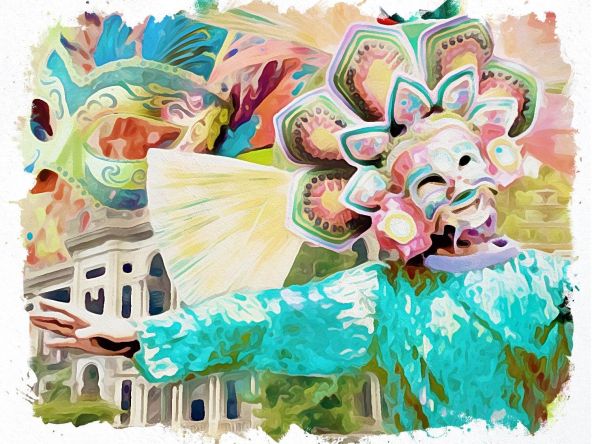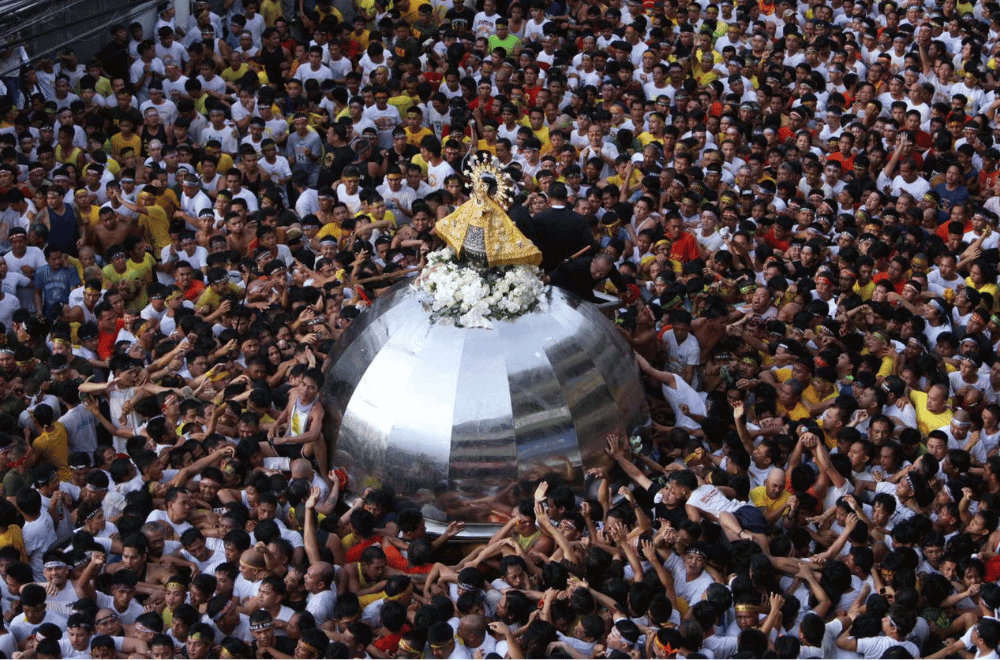
Photo courtesy: Naga City Tourism
Introduction to the Feast Day of the Lady of Peñafrancia
Faith has always been at the heart of Filipino life, and among the countless devotions across the country, few are as powerful, vibrant, and enduring as the Peñafrancia devotion in the Philippines.
For more than three centuries, this devotion has united the faithful in Naga City and the wider Bicol region, drawing millions each year to honor the lady of Peñafrancia.
September marks the annual Peñafrancia festival. Unlike other Marian devotions, such as the Our Lady of Manaoag or the Our Lady of Antipolo, the Peñafrancia devotion is deeply tied to place, history, and the story of a Spanish priest who brought the devotion from Spain to the Philippines.
Generations of families return home during this time to celebrate the feast day, join in the community and thanksgiving mass, and walk the major streets of the city as church bells peal, reminding all of the loving Virgin who has become their patroness.
Origins of the Peñafrancia Devotion in the Philippines
The roots of this devotion trace back to San Martín del Castañar in Spain, where a hermitage was built in honor of Our Lady of Peñafrancia, originally inspired by the peña de Francia mountain.
The devotion spread after the 15th century, with support from King Juan II of Spain and recognition by Pope Martin, which helped embed it within formal religious rites.
Miguel Robles de Covarrubias and His Vow
In the Philippines, the devotion began through Miguel Robles de Covarrubias, a Spanish priest and the first parish priest of Naga. Deeply devoted to the Blessed Virgin Mary, he vowed to honor her if she granted him healing from illness.
When the healing happened immediately, he fulfilled his promise by building the old Peñafrancia shrine along the banks of the Bicol River, enshrining a replica of the miraculous image he brought from Spain.
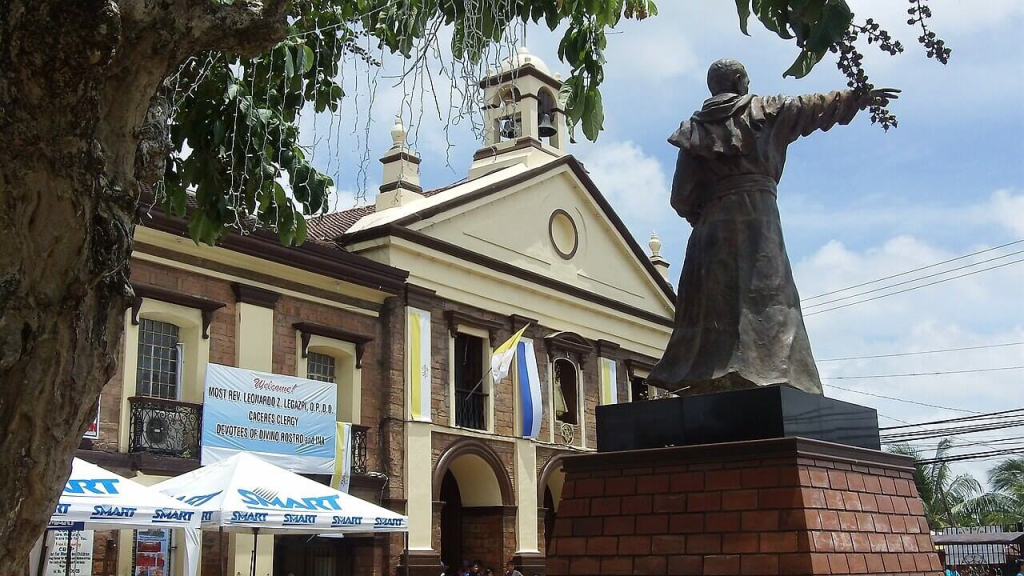
The Legacy of Juana Hernández, La Moza Santa
The devotion to Our Lady of Peñafrancia also recalls the story of Juana Hernández, a devout Spanish maiden known as La Moza Santa, or “the holy youngster.”
Living near Salamanca in the 15th century, she was among the earliest to inspire veneration of the Virgin connected to the peña de Francia mountain.
On her deathbed, she urged those around her with the words: “Turn your faces to Mt. Peña de Francia and pray to the Virgin Mary.”
Building Faith in Early Churches and Shrines
As devotion grew, the faithful needed bigger sacred spaces. From the old Peñafrancia shrine, a new and bigger church was envisioned.
Families, civic leaders, and local government officials contributed resources, while government workers and volunteers helped with the construction.
Naga Cathedral and the Minor Basilica as Centers of Devotion
The devotion’s early years centered around the Naga Cathedral, later known as the Naga Metropolitan Cathedral, which became the central site for pontifical mass, processions, and gatherings.
The parish priest and clergy organized the nine-day novena, guiding the faithful in preparing for the grand festivities. Eventually, the minor basilica was established, providing a permanent sanctuary for the holy image.
The Role of Clergy and the Vicar General in the Peñafrancia Festival
During the Peñafrancia celebrations, the cathedral and vicar general play central roles in organizing the liturgical aspects of the feast.
From overseeing the solemn pontifical mass at the Naga Metropolitan Cathedral to guiding the nine-day novena, their presence ensures that the religious core of the festivities remains intact even amid large civic events.
Their coordination with parish priests, lay leaders, and devotees underscores the balance between spiritual devotion and the wider community activities that the Peñafrancia festival brings.
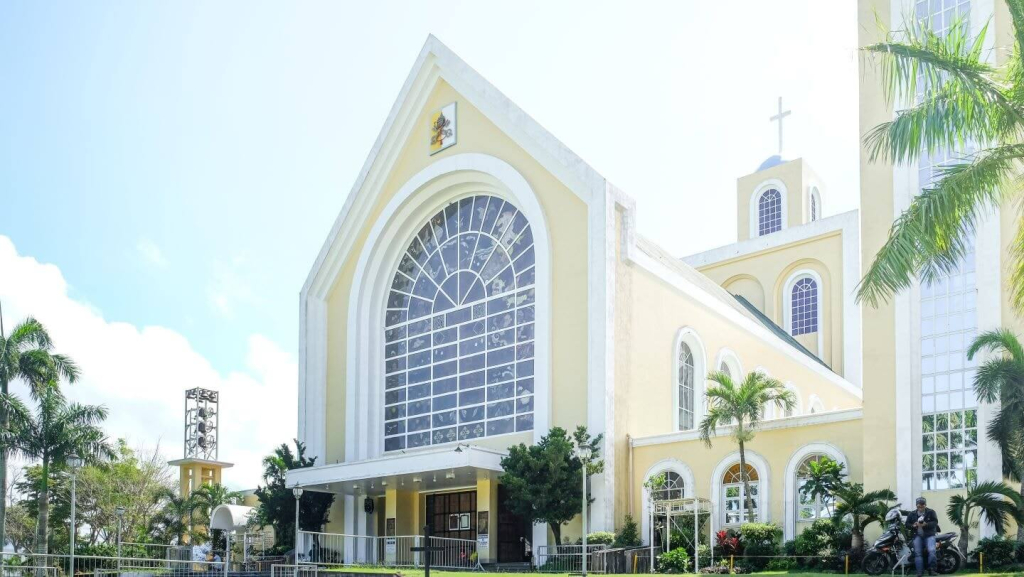
Cultural Expressions of Devotion to the Lady of Peñafrancia
For nine days, devotees attend novenas and the solemn pontifical mass led by an auxiliary bishop or an apostolic delegate. The final day culminates in the fluvial procession, but the lead-up is filled with lively events.
The civic parade features schools, businesses, and local groups. Drum and lyre corps provide rhythm as the float parade rolls down the major streets, showcasing devotion through artistry.
Cultural Expressions Through Parades, Dance, and Music
A street dance competition and regional cheer dance competition bring color and energy, reflecting how the devotion inspires creativity as much as piety.
During the cultural festivities, floats are often designed with more than one tier, showcasing not only Marian imagery but also themes of local history, arts, and faith.
All these creative expressions highlight how devotion and culture intertwine in the Bicolano identity. Music plays a central role as well, with bands and choirs competing for the best musical composition.
Philippine Art Inspired by the Lady of Peñafrancia
Beyond parades and performances, the Penafrancia devotion in the Philippines has also inspired remarkable contributions to Philippine art. In Naga, artworks by artists such as Pancho Piano narrate the journey of devotion from Spain to the heart of the Bicol region.
Contemporary artists like Keith Anne Nase add to this heritage with works such as Panata, which portrays voyadores carrying the holy image in vibrant colours, showcasing the glorious image of the Lady of Peñafrancia and the infant Jesus.
Family and Community Traditions During the Feast Day
At home, families set up altars with other images of the Virgin Mary, candles, and flowers. Songs are sung, and prayers whispered as households prepare for the feast day.
Community ties strengthen through the community and the Thanksgiving mass, where neighbors gather and reaffirm their devotion.
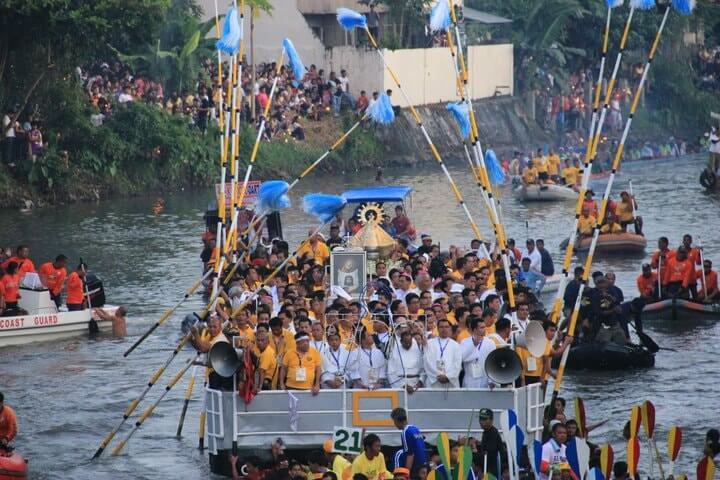
Image source: https://commons.wikimedia.org/w/index.php?curid=59076008
The Fluvial Procession as the Heart of the Peñafrancia Festival
If there is one moment that defines the Peñafrancia devotion in the Philippines, it is the fluvial procession.
Held every third Saturday of September, this solemn yet spectacular event sees the holy image placed on a decorated shrine barge, accompanied by a multicolored pagoda carrying clergy and lay leaders.
Candles, Voices, and Safeguards on the Bicol River
The fluvial procession marks the climax of the festival. For two or three hours, the Bicol River becomes a sea of light as candles float on the water and the voices of thousands chant prayers.
The armed forces, Boy Scouts, and the Philippine National Police join civic volunteers in ensuring safety, as boats, barges, and rafts fill the waterway.
The procession eventually reaches the cathedral grounds, where a solemn pontifical mass is held. Along the way, the holy image passes Plaza Quezon and the major streets of Naga, acting as the host city, bringing devotion into the public square.
The Colgante Bridge Tragedy and Lessons in Safety
The Peñafrancia Festival also carries memories of sorrow, most notably the Colgante Bridge tragedy in 1972. During the fluvial procession, the suspension bridge over the Bicol River collapsed under the weight of thousands of spectators eager to witness the passing of the decorated shrine barge.
Many lives were lost, casting a shadow over what is usually a joyful celebration.
Living Near the Heart of Devotion in Naga City
Here, the tie between faith and daily living becomes clear. Families who live in communities close to the basilica and the riverbanks, such as those in Camella Homes, enjoy the privilege of accessibility.
Their homes provide them proximity not only to the Naga Cathedral and minor basilica, but also to the festival routes themselves.
This closeness makes it easier for them to pass traditions to their children, participate in processions, and join the festivities each year without worrying about long commutes or missing key moments.
Stories of Miracles and Faith of Nuestra Señora de Peñafrancia
Central to the devotion are stories of intercession. Devotees recount how the blessed Virgin saved lives, healed sicknesses, and protected families during calamities.
From typhoons in the Bicol region, leading towns to accidents where survivors claimed protection from the Lady of Peñafrancia, testimonies abound.
The first miracle, as mentioned, was when healing happened immediately to Miguel Robles de Covarrubias. Since then, many miracles have been attributed to her. Fishermen lost at sea found their way back after invoking her name.
Families prayed during illnesses and recovered against odds. The devotion tells of a young girl saved from death after her parents called upon the holy face of the Virgin.
For Bicolanos, these stories are proof that the Blessed Mother intercedes for her children. The canonical coronation of the image in the 1920s cemented her place as a patroness recognized by Rome.
Devotees see her not just as another version of Mother Mary, but as a local icon whose presence in their lives is undeniable.
Chanting Viva La Virgen in the same voice, they declare their faith, affirming that through the lady of Peñafrancia, they are drawn closer to Jesus Christ.

Conclusion
For over 300 years, the Peñafrancia devotion in the Philippines has endured as a symbol of resilience, unity, and unwavering faith.
It has survived wars, calamities, and modern distractions, proving that the loving Virgin continues to inspire her people.
In the end, the lady of Peñafrancia is a reminder that faith, once embraced, can become a legacy. To pay homage to her is to affirm not just tradition but also hope for the future.
The Peñafrancia festival is a living testament to how belief in the Virgin Mary, the child Jesus, and the Blessed Mother carrying her son continues to guide generations in the Bicol region and beyond.

